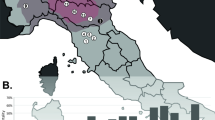Abstract
A mutant allele of the chemokine receptor CCR5 gene (CCR5-Δ32), which confers resistance to HIV-1 infection, is believed to have originated from a single mutation event in historic times, and rapidly expanded in Caucasian populations, owing to an unknown selective advantage. Among other candidates, the plague bacillus Yersinia pestis was implicated as a potential source of strong selective pressure on European populations during medieval times. Here, we report amplifications of the CCR5-Δ32 DNA sequence from up to 2900-year-old skeletal remains from different burial sites in central Germany and southern Italy. Furthermore, the allele frequency of CCR5-Δ32 in victims of the 14th century plague pandemic in Lübeck/northern Germany was not different from a historic control group. Our findings indicate that this mutation was prevalent already among prehistoric Europeans. The results also argue against the possibility of plague representing a major selective force that caused rapid increase in CCR5-Δ32 gene frequencies within these populations.

Similar content being viewed by others
References
Berger EA, Murphy PM, Farber JM . Chemokine receptors as HIV-1 coreceptors: roles in viral entry, tropism, and disease. Annu Rev Immunol 1999; 17: 657–700.
Ansari-Lari MA, Liu XM, Metzker ML, Rut AR, Gibbs RA . The extent of genetic variation in the CCR5 gene. Nat Genet 1997; 16: 221–222.
Carrington M, Kissner T, Gerrard B, Ivanov S, O'Brien SJ, Dean M . Novel alleles of the chemokine-receptor gene CCR5. Am J Hum Genet 1997; 61: 1261–1267.
Howard OM, Shirakawa AK, Turpin JA et al. Naturally occurring CCR5 extracellular and transmembrane domain variants affect HIV-1 co-receptor and ligand binding function. J Biol Chem 1999; 274: 16228–16234.
Blanpain C, Lee B, Tackoen M et al. Multiple nonfunctional alleles of CCR5 are frequent in various human populations. Blood 2000; 96: 1638–1645.
Dean M, Carrington M, Winkler C et al. Genetic restriction of HIV-1 infection and progression to AIDS by a deletion allele of the CKR5 structural gene. Science 1996; 273: 1856–1862.
Samson M, Libert F, Doranz BJ et al. Resistance to HIV-1 infection in caucasian individuals bearing mutant alleles of the CCR-5 chemokine receptor gene. Nature 1996; 382: 722–725.
Liu R, Paxton WA, Choe S et al. Homozygous defect in HIV-1 coreceptor accounts for resistance of some multiply-exposed individuals to HIV-1 infection. Cell 1996; 86: 367–377.
Martinson JJ, Chapman NH, Rees DC, Liu YT, Clegg JB . Global distribution of the CCR5 gene 32-basepair deletion. Nat Genet 1997; 16: 100–103.
Libert F, Cochaux P, Beckman G et al. The deltaCCR5 mutation conferring protection against HIV-1 in Caucasian populations has a single and recent origin in Northeastern Europe. Hum Mol Genet 1998; 7: 399–406.
Stephens JC, Reich DE, Goldstein DB et al. Dating the origin of the CCR5-Delta32 AIDS-resistance allele by the coalescence of haplotypes. Am J Hum Genet 1998; 62: 1507–1515.
Hummel S . Ancient DNA: Recovery and Analysis. Encyclopedia of the Human Genome. Nature Publishing Group: London, 2003.
Hummel S . Ancient DNA Typing. Methods, Strategies and Applications. Springer: Heidelberg, 2002.
Cooper A, Poinar HN . Ancient DNA: do it right or not at all. Science 2000; 289: 1139.
Dean M, Carrington M, O'Brien SJ . Balanced polymorphism selected by genetic versus infectious human disease. Annu Rev Genomics Hum Genet 2002; 3: 263–292.
Lalani AS, Masters J, Zeng W et al. Use of chemokine receptors by poxviruses. Science 1999; 286: 1968–1971.
Galvani AP, Slatkin M . Evaluating plague and smallpox as historical selective pressures for the CCR5-Delta 32 HIV-resistance allele. Proc Natl Acad Sci USA 2003; 100: 15276–15279.
Mecsas J, Franklin G, Kuziel WA, Brubaker RR, Falkow S, Mosier DE . CCR5 mutation and plague protection. Nature 2004; 427: 606.
Bramanti B, Hummel S, Schultes T, Herrmann B . STR allelic frequencies in a German skeleton collection. Anthropol Anz 2000; 58: 45–49.
Schultes T, Hummel S, Herrmann B . Amplification of Y-chromosomal STRs from ancient skeletal material. Hum Genet 1999; 104: 164–166.
Schmidt D, Hummel S, Herrmann B . Brief communication: multiplex X/Y-PCR improves sex identification in aDNA analysis. Am J Phys Anthropol 2003; 121: 337–341.
Bramanti B, Hummel S, Chiarelli B, Herrmann B . Ancient DNA analysis of the delta F508 mutation. Hum Biol 2003; 75: 105–115.
Baron H, Hummel S, Herrmann B . Mycobacterium tuberculosis complex DNA in ancient human bones. J Archaeol Sci 1996; 23: 667–671.
Acknowledgements
We thank A Rosenberger for detailed statistical analysis and S Flindt, L Klappauf and B Bramanti for the skeletal sample materials. The study was supported by a grant of the Federal Ministry of Education and Research to SH.
Author information
Authors and Affiliations
Corresponding author
Additional information
Supplementary Information accompanies the paper on Genes and Immunity (http://www.nature.com/gene).
Supplementary information
Rights and permissions
About this article
Cite this article
Hummel, S., Schmidt, D., Kremeyer, B. et al. Detection of the CCR5-Δ32 HIV resistance gene in Bronze Age skeletons. Genes Immun 6, 371–374 (2005). https://doi.org/10.1038/sj.gene.6364172
Received:
Revised:
Accepted:
Published:
Issue Date:
DOI: https://doi.org/10.1038/sj.gene.6364172
- Springer Nature Limited
Keywords
This article is cited by
-
Pharmacogenomic implications of the evolutionary history of infectious diseases in Africa
The Pharmacogenomics Journal (2017)
-
Harnessing ancient genomes to study the history of human adaptation
Nature Reviews Genetics (2017)
-
Archaeogenetics in evolutionary medicine
Journal of Molecular Medicine (2016)
-
Re-inventing ancient human DNA
Investigative Genetics (2015)
-
The Osteological Paradox 20 Years Later: Past Perspectives, Future Directions
Journal of Archaeological Research (2015)




